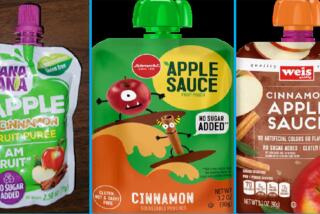Pesticide May Peril Children When Used on Bananas and Potatoes, EPA Study Says
- Share via
WASHINGTON — A division of the Environmental Protection Agency, raising new concerns about risks posed by chemicals in children’s diets, has recommended banning the use of an acutely toxic insecticide on potatoes and bananas, agency officials said Tuesday.
The recommendation, currently under review at the agency, is based on a study that found residues of the insecticide, aldicarb, in the two crops in quantities that researchers feared might endanger the health of infants and children.
The highest level of aldicarb found in the study was only one-fifth of the level that the EPA says poses a health hazard, and the agency reported no evidence that ill effects had actually occurred.
Risks ‘Exceed Benefits’
Nevertheless, EPA researchers, adopting a cautious standard, concluded that the risks of using the insecticide “exceed the benefits when aldicarb is used on bananas and potatoes.”
There are fears that aldicarb could cause adverse effects in concentrations below the acceptable level, the scientists indicated. They said that they found aldicarb residues in some potatoes in quantities sufficient to potentially cause stomach cramps, headache, nausea and irritability in children.
Their report estimated that 15,000 to 50,000 infants and children a day are exposed to enough aldicarb to present a risk of illness from eating potatoes and that bananas present a risk for as many as 1,500 small children.
A spokeswoman for Rhone-Poulenc, which manufactures the pesticide, criticized the report for focusing on “hypothetical margins of safety.”
“There has never been a case of illness resulting from ingestion of these crops,” the spokeswoman, Mary Anne Ford, said.
Report Not Released
The EPA refused to release a copy of the report, which was submitted to Deputy Administrator John A. Moore on Jan. 18. Officials said that the methodology used by the researchers in the special review and reregistration branch of the pesticide division must be evaluated before the agency can judge whether the pesticide poses a “dietary risk.”
The disclosure about potential hazards in potatoes and bananas is likely to add to concerns sparked last month by an environmental group that charged that apples treated with Alar, a growth enhancer, posed an “intolerable risk” to children.
Those accusations were challenged by the EPA and other government agencies, which urged Americans to continue eating apples and apple products. But some school districts, including Chicago, continue to ban apples and apple products from lunch menus.
Ford, the Rhone-Poulenc spokeswoman, said the company fears that “general alarm in the public” would make it difficult for parents to make reasoned decisions about their children’s diets.
“This is an unfounded alarm,” she said. “I truly feel for the parents who have had another food residue issue raised.”
Use on Other Crops
The preliminary EPA recommendations would allow continued use of aldicarb on a number of crops on which only insignificant residues were found, including oranges, grapefruit, limes and peanuts.
The highly toxic insecticide is made from methyl isocyanate, the chemical that leaked from the Union Carbide plant in Bhopal, India, in a 1984 accident that killed more than 2,000 people. In this country, aldicarb applied illegally to watermelons by three California growers in 1985 caused the illness of about 1,000 people in eight Western states.
Aldicarb, known by its brand name, Temlik, is used on approximately half of the U.S. potato crop and is widely used by foreign banana growers whose produce is imported into the United States. It is so toxic that the EPA regards one part per million in potatoes as unsafe. But it breaks down, leaving only trace residues.
State Found No Hazard
A spokesman for the California Department of Agriculture said that its testing of 939 bananas and potatoes in the last three years had discovered residues of aldicarb in only one potato and, in that case, the concentration was far below the level considered hazardous by the EPA.
The state uses the EPA’s standards in testing all food to determine whether it is safe for consumption.
A 1987 study sponsored by Rhone-Poulenc found aldicarb residues in 5% of potatoes and slightly more than 2% of bananas. None of the residues exceeded the EPA tolerance.
The preliminary EPA report suggested that the agency should impose a margin of safety that would regard aldicarb concentrations of one-tenth the current standard as too risky to tolerate.
But Rick Tinsworth, director of the division that produced the study, said that it would be “inappropriate to condemn a particular crop” until the issue had been reviewed by the scientific review board.
More to Read
Sign up for Essential California
The most important California stories and recommendations in your inbox every morning.
You may occasionally receive promotional content from the Los Angeles Times.













